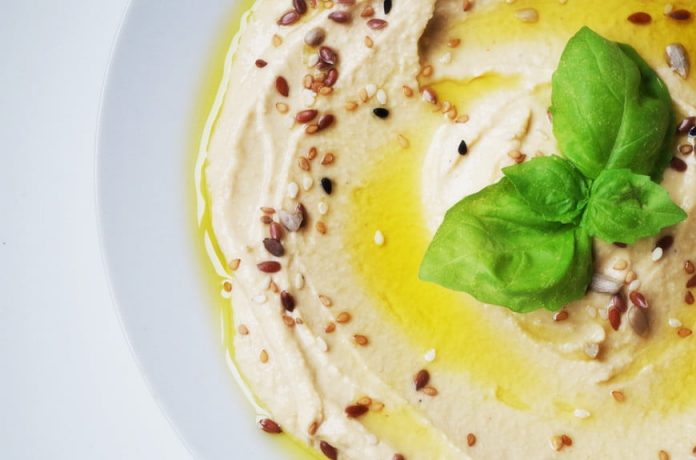Hummus is a staple mainly in Mediterranean households, but nowadays, you can easily find it in State-side and British supermarkets. It is not so difficult to understand why hummus is gaining popularity worldwide. Hummus is lip-smacking and healthy!
From the standpoint of many food lovers, hummus is hard to resist because it tastes great and it’s wholesome. But can you safely give it to a dog? We all know certain foods, no matter how healthy they are for us humans, can’t be given to canines. Is hummus among them? Let’s hear it from the experts.
What’s in Hummus?
The main ingredient of basic hummus is chickpeas, which are actually safe for canines. Your dog can gain from the protein and fiber content of hummus. The other ingredients of hummus are the ones to keep an eye on.
The thing is, hummus can’t be made without garlic. Some people tried making hummus without it and ended up unsatisfied. Garlic is a flavor powerhouse that makes hummus more appetizing. Let’s add the fact that garlic is a superfood with many surprising health benefits, such as fighting high blood pressure and cardiovascular diseases.
While garlic is good for you, it isn’t always the case for your dog. The garlic is universally accepted as a dog food ingredient. On the other hand, the large doses of garlic can be toxic to dogs. Garlic is considered toxic to canines because they cannot digest Allium plants.
Apart from garlic, there are other ingredients in hummus. Let’s see whether they are safe or not.
Tahini – is a paste made from ground sesame seeds. Tahini or sesame seeds are not toxic to dogs.
Lemon juice – is not safe for dogs because it is too acidic for them. It can only cause stomach upset as well as diarrhea for them.
Salt – a recipe for six to eight servings of hummus calls for a teaspoon of salt. Too much salt causes sodium ion poisoning in canines. A report by the National Academies of Sciences Engineering Medicine indicated that dogs weighing around 33 lbs. should not consume more than 100 mg of sodium per day. A teaspoon of salt is already equivalent to 2,300 mg of sodium, way too much than the recommended sodium amount for canines.
Most brands of canned hummus have a sketchy sodium content. For instance, there is one brand with 150 mg of sodium for every two tablespoons. That is quite a lot! Imagine if your pet consumed an entire bottle! While hummus is not meant to have sugar in it, there are actually store-bought types of hummus that contain artificial ingredients like guar gum and citric acid.
Here are the other ingredients in most hummus recipes, and their possible effects on dogs:
Paprika – this is one of the spices that should be avoided for dogs because it is known to cause skin and eye irritation.
Extra virgin olive oil – is safe for dogs in moderate amounts. It can be added to a dog’s diet because it can protect against heart disease. When your dog has weight-gain and obesity issues, adding extra virgin olive oil in his food could help.
Caramelized onions – like garlic, onions are among the Allium family that is considered toxic for canines. The thiosulphate in onions is believed to cause hemolytic anemia in dogs, a condition that impairs your pet’s red blood cells production.
Walnuts – there are unique hummus recipes that use walnuts as the main ingredient. Unfortunately, walnuts are quite hard to be digested by our pets and their fat content is too high for them.
Jalapeño – thinking of Jalapeño Apricot Lentils Hummus will make you go hungry, but jalapeños are not good for doggies. Our pets are not meant to eat spicy things, including jalapeño peppers.
Avocado – there are hummus recipes that use avocado. There is an ongoing debate whether avocados are safe for dogs or not. The American Kennel Club said avocado is considered toxic due to its persin content. Persin is known to cause heart failure and death in many animals. The only good news, somehow, is that dogs are more resistant to persin compared to other animals.
What If My Dog Ate Hummus?
Our fur babies love exploring with food as much as we do, even if they are not aware of what effects the things they eat may have on them. If your pup accidentally ate hummus, he will likely experience transient gastrointestinal distress mostly because of the garlic. The odds of garlic toxicity in canines greatly depend on the size of the dog and the amount of garlic in the hummus. These are the symptoms to keep an eye out for:
- Inappetence or lack of appetite
- Vomiting
- Diarrhea
Do note that the symptoms will not occur immediately. It may take a few hours before your dog throws up or has frequent trips to the bathroom after consuming hummus. If you are quite sure the hummus contains more than a clove of garlic and your dog already looks queasy, better take him to an emergency vet.
Should you make your dog throw up? No, especially if you are unsure how to induce emesis. Making a pet throw up is not always the best option. If you think induced vomiting is the only solution, consult your vet first.
The safest way to induce vomiting in dogs is by administering a 3% hydrogen peroxide solution. The dosage is 2.2 ml for every kilogram of your dog’s body weight. According to the Dr. Christie Long, it is best to leave induced vomiting to the professionals who were trained on how to minimize the risk of aspiration.
Aspiration can happen when the vomit re-routes to the air passages through the trachea and into your dog’s lungs. It can lead to serious health problems, including pneumonia.
Conclusion
Looking at the ingredients in hummus, it is safe to say that it is bad for dogs. The garbanzo beans or chickpeas are safe for them but the rest of the ingredients can be harmful to them. One of those harmful ingredients is garlic, which can be toxic to dogs in high amounts. The lemon juice, salt, as well as the other spices can also upset your pup’s stomach.
In case your dog got curious and licked some hummus from your leftovers, don’t panic. He will surely be fine. If he ate too much, expect gastrointestinal distress in the symptoms of diarrhea and vomiting. Don’t try to make him vomit right away, unless your vet says it is fine to do so.























